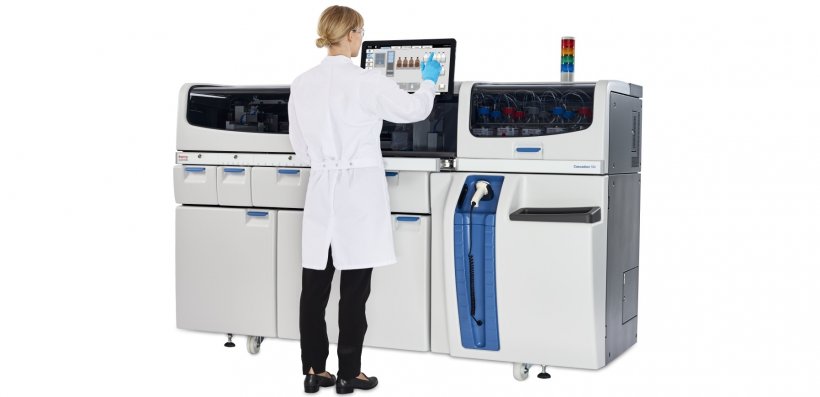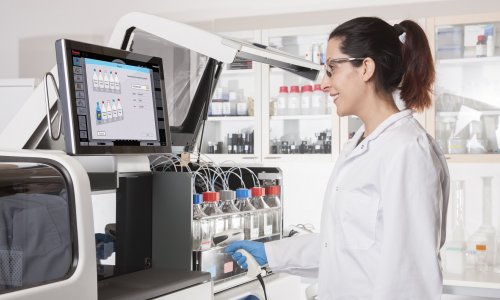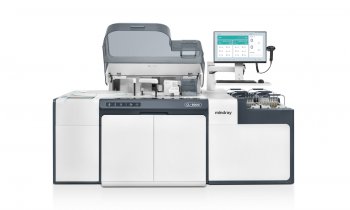Sponsored • Testing technology
Vitamin D testing: LC-MS outperforms immunoassays
Report: Daniela Zimmermann
In recent years, clinicians have increasingly focused on vitamin D deficiency. Studies show that previous reference values – particularly for vitamin D3 – were most probably set too high.
Liquid chromatography with mass spectrometry (LC-MS) can help achieve more precise measurements of vitamin D levels than previously established immunoassay procedures, explains Dr Torsten Binscheck-Domass, formerly a pharmacologist and toxicologist at the joint laboratory of the Charité and the Vivantes Group in Berlin, and an expert in clinical mass spectrometry at Thermo Fisher Scientific. However, in its current shape this complex technology is not suitable for all laboratories.

Although the relevance of the threshold values remains controversial, there is agreement on one point: Vitamin D deficiency is associated with a range of clinical pictures, such as osteomalacia or respectively, rickets in children, as well as with increased susceptibility to infections. In the aged, a lack of vitamin D can also have severe consequences, as Binscheck-Domass explains: ‘Studies are currently being carried out to examine a correlation between vitamin D deficiency in older patients and osteoporosis as well as a reduction in muscle strength, which leads to an increased risk of falls. For older patients, falls are complications that can have severe consequences, such as fractures, traumatic brain injuries and long-term hospitalisation, etcetera.’
UV-radiation from the sun is a natural remedy, but is often not enough. ‘We recommend vitamin D screening for people with little exposure to sunlight, particularly for vitamin D3,’ he adds. Basically, everyone whose face, hands, and ideally also lower arms, are exposed to the sun for at least 30 minutes twice a week should absorb sufficient vitamin D3 to also last them through longer periods without sunlight. However, deficiencies are documented for hospitalised patients, people in nursing homes and sometimes even for children and adolescents who spend little time outdoors. Vitamin D2, which is mainly absorbed via nutrition – such as edible mushrooms – plays a slightly less important role.
LC-MS separates the wheat from the chaff
One problem with measuring vitamin D levels in the body is that the different intermediate products are often very similar and cannot be differentiated correctly with antibody-based tests such as immunoassays. Together with the comparatively low concentration of calcitriol – the biologically active form – this often leads to measurement values that have little significance, the expert points out. LC-MS has a big advantage here as it can separate the biologically inactive epimers from the molecule of the vitamin. Therefore, LC-MS-based diagnosis achieves significantly higher specificity.
Currently there are still hurdles which laboratories need to overcome when switching from immunoassays to LC-MS, Binscheck-Domass explains; this centres less around the associated costs – the acquisition requiring investments in the mid-six figure range, depending on the device – but rather the changes to the normal work flows: ‘These are complicated devices and you need trained staff who can not only operate the equipment but also carry out evaluations.’ Furthermore, some laboratories are deterred by regulatory requirements because the qualification of the systems requires a lot of effort, with numerous calibration and test runs.

Source: Thermo Fisher Scientific
Automation reduces human error
The expert emphasises that switching to the new technology is worth the effort. ‘The fact that the LC-MS can measure both types of vitamin D, D3 and D2 simultaneously and separately in one single measurement is a considerable advantage. These values are adjusted for the epimers, delivering a clinically valid result.’
There is no need for extensive extraction, accumulation or derivatisation procedures that had to be manually carried out with earlier LC-MS procedures. This not only reduces the staffing requirements, but also the error rate. ‘Humans mix up samples, or overlook things – machines do not. Moreover, every single manipulation, every individual analytical step is documented,’ Binscheck-Domass points out. ‘In other words, the traceability of the result is complete. In this respect, the principle is equal to that of a classic chemical analyser in a clinical laboratory.’
Manufacturer delivers IVD ready
The EU guideline will force laboratories that work with open systems to change their procedures substantially
Torsten Binscheck-Domass
The lack of standardisation for these procedures is creating some tension. In the USA, the systems need IVD certification, and in the EU this will also be required from 2022. Many clinical laboratories currently still work with open systems. For these laboratories the switch of the devices to IVD-conformity standards is almost impossible to implement on their own, Binscheck-Domass says. ‘The EU guideline will force laboratories that work with these systems to change their procedures substantially.’ However, here the industry is delivering a possible solution. Companies such as Thermo Fisher Scientific offer solutions in which the technical system, as well as the assays, are already IVD-certified. This saves the laboratories lengthy test runs, which would otherwise be necessary for a qualification.
Profile:
Torsten Binscheck-Domass MD is a Systems Lead Scientist in Clinical Mass Spectrometry at Thermo Fisher Scientific. Qualified in medicine, he is a medical and forensic expert consultant in analytical pharmacology and toxicology. He has more than 25 years of experience in the fields of therapeutic drug monitoring, drugs of abuse testing and systematic toxicological analysis. Dr Binscheck-Domass is a strong advocate of clinically applied LC-MS/MS and has been exploring the technology’s unique benefits to clinical labs for more than 10 years.
05.09.2018












